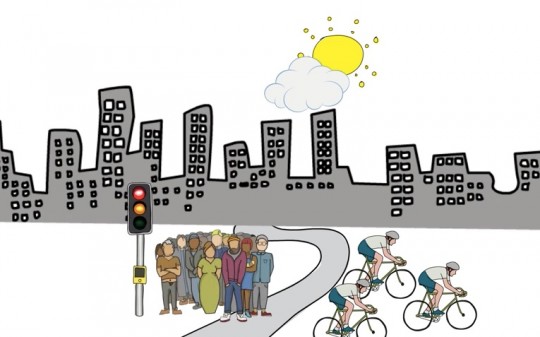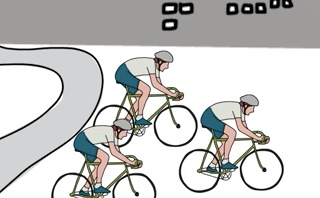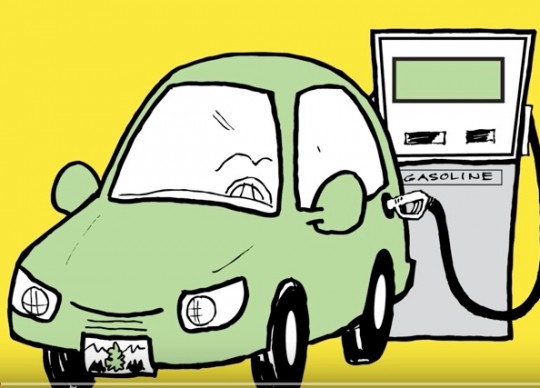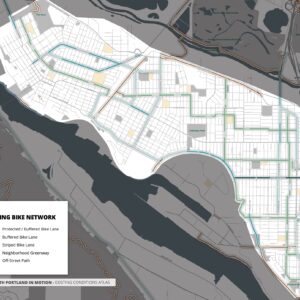As we shared last month, the Oregon Department of Transportation has finished the first draft of a major update to our Bicycle and Pedestrian Plan.
Depending on how it ends up, this plan could be big deal because it will lay the foundation on which ODOT will base its bicycle-related project, planning, and policy decisions for many years to come. It could also give all Oregonians valuable leverage to hold leaders accountable.
But in case you haven’t noticed, ODOT can’t be trusted to make this plan as good as it needs to be. That’s where you come in. To their credit, ODOT is reaching out to the public and asking for advice and input on how to make the plan better.
Advertisement
Along with a public comment period that opened last month and runs through February 18th, they’ve just announced a public open house (4-6:30 pm on 12/14 at 8114 SE Division) and they’ve put out a new video. We just came across the video this morning. It’s short and sweet and comes complete with a squeaky-voiced narrator who sounds like the nicest person on the planet.
[Warning: digression/rant ahead]
Unfortunately the video also comes with images of people on bikes who look like they are competing in the Tour de France. It’s frustrating to see ODOT choose bent-over racers to represent cycling in Oregon. Those images do not reflect what most of our bicycling public actually looks like. If this is what ODOT thinks bicycle riders look like, is it any surprise they think unprotected bike lanes on streets urban highways where people drive 45-50 mph is acceptable?
If we want to encourage more Oregonians to give biking a try (which we most certainly do), it makes no sense to present them with an image they cannot relate to at all.
Does ODOT use a NASCAR when they show cars in their animated videos? Would they show a person walking with running shoes, a tank top, and running shorts? Nope. Because that’d be crazy right?
Notice the nice, friendly, boring car in one of their videos below…
Sorry for the digression…Back to the Bike/Ped Plan.
Now is the time to visit the plan’s website read through it and give ODOT your input. You can email comments to ORBikePedPlan@odot.state.or.us. The open house is from 4-6:30 pm on December 14th at Jade/APANO Multicultural Space (8114 SE Division). The comment period closes February 18th.
— Jonathan Maus, (503) 706-8804 – jonathan@bikeportland.org







Thanks for reading.
BikePortland has served this community with independent community journalism since 2005. We rely on subscriptions from readers like you to survive. Your financial support is vital in keeping this valuable resource alive and well.
Please subscribe today to strengthen and expand our work.
I’ve always thought the grills of a car look like faces. The one above looks kind of angry.
I believe the facelike appearance is intentional, and that it helps set the “tone” the car is trying to convey (friendly, aggressive, fast, etc.)
Yeah I think you’re right, it’s absolutely intentional. Rapaille in The Culture Code explains how, while consulting for Chysler, he convinced the company to revert Jeep Wrangler’s headlights from square back to round. His rationale is that Americans’ “code” for a Jeep is “horse.” The consuming public didn’t like it when Jeep made the horse’s eyes rectangular.
I’m pretty sure the original VW bugs front bumpers were intentionally designed to give the impression of a happy face -especially effective with those big round eyes.
I read a serious article explaining how the latest Mustangs were designed to suggest Steve McQueen’s face. The designer had a large postetr of McQueen in his workspace for inspiration. Just reporting what I read.
I do not trust ODOT to do anything right, even if they said ALL the right things about bikes at the planning stage. They are a criminal organization, and the entire leadership needs to be cleaned out.
Did you even watch the video here? Every organization has its flaws sure, some more than others. We can expect some issues to remain unchanged for some time or decisions to be made that we don’t agree with. Failed decisions and mistakes are inevitable, this is how change and growth happen. Dramatic mindsets like that only hold humanity back, this isn’t ISIS we’re talking about. How about instead of simply complaining about ODOT here you actually GO TO TINYURL/OREGONBIKEPLAN, REVIEW THE PLAN AND OFFER SOME REAL IDEAS OR SOLUTIONS AS THEY ARE ASKING FOR OR PARTICIPATE IN THE ONLINE OPEN HOUSE IN DECEMBER; maybe they will make use of these ideas, maybe they won’t but at least that would be a real effort on your behalf rather than just sitting here spreading ignorance. Before someone comes back with “some of these choices cost lives” nonsense, there are a number of factors in any given road death and these situations are far to complex to be blamed on infrastructure alone.
Honest question: who in their right mind is going to read a 136 page report? Why is there no summary, a top 10 of sorts? This report doesn’t describe anything specific; such as locations that need improvenent, what kind of infrastructure could be built, or where the money will come from. This report is so long and complex that it’s easy to miss information buried within.
http://www.oregon.gov/ODOT/TD/TP/BikePed/Draft_ExecutiveSummary_PublicReview.pdf
Some of us have read it.
There is an 10 page executive summery you can download too if you’re lazy.
http://www.oregon.gov/ODOT/TD/TP/BikePed/Draft_ExecutiveSummary_PublicReview.pdf
And unless you like debating from an obvious point of ignorance and If you really are at all interested in the subject I’d recommend actually reading the long version. Knowledge is power.
This is important. It’s statewide policy change and this doesn’t come up everyday. If you’re truly interested in transportation policy, funding, and it’s future in Oregon this is hands down more important than the up coming elections next year.
And for me personally, if anyone isn’t willing to do the homework on something like this, I find no value in their opinions or suggestions, and I find their intentions are suspect.
In my worthless opinion, a good plan would be much simpler than even the 10 page summary. Attempting to preserve motorized speed and connectivity (they call this “freight”) at the expense of walking/biking makes it complicated because numbers don’t play these games. The simplest thing (slow down traffic and stop adding capacity) is unpopular, dirt cheap, and clearly necessary (unless they were lying about the goals #1-9.)
Well had you actually read the draft, reduction of speed limits is on the table. As is connecting incomplete bicycle and walk facilities, and increasing bike parking, more cooperation with local governments and agencies, more money for active transportation, better funding for bicycle tourism, and a myriad of other things which many of us have wished for for a very long time.
It might not be perfect, but it’s a huge step in the right direction from an organization that has been striking out for a long time across multiple fronts (like the CRC and the recent carbon emissions scandal) – they need a win and this might very well be it.
Thank you for the succinct summary. Most of that is already buried just in the summary. If the people we pay for this work could get the plan down to 10 pages and the summary into 10 paragraphs, it might even be useful. Perhaps the excessive repetition is a necessity of government work (safety is goals 1-3 and 1-6, and I probably missed the section where it is goals A-C.)
Or maybe big plans just don’t matter. Does the current state of Barbur match the 1995 plan? (Which at least gets into specifics like page 50 (66 in the pdf) and much more design which seems to have gone unimplemented.) Page 207 has the same “20 is plenty” info and yet [insert name of favorite ODOT stroad here]. At least one ODOT employee biked to work in Salem back then.
http://www.oregon.gov/ODOT/HWY/BIKEPED/docs/or_bicycle_ped_plan.pdf
To read either of them, you would think ODOT actually intended to prioritize walking and biking.
Releasing a 130 page report to the public and expecting people to comment on it is purposeful obfuscation. You just end up with comments only from the people who bothered to read it; hardly representative of the general population.
I have to ask – do you really think that comments and public process participation can contribute meaningfully to the sea change in policy that would have to happen in order for ODOT to provide safe and comfortable biking and walking facilities? I’m all for such things when directed at organizations that have their heart in the right place but just need a little pick-me-up (e.g. PBOT, Multnomah County). But for an organization like ODOT where the leadership seems indifferent to our concerns, I think spending one’s energy on participating in their public process is not the best use of time. The leadership needs to change or be given a stern talking to by the Governor before I believe anything substantive will happen.
I think organizing towards creating a political force for biking, walking, and road safety that has one hundredth of the power of business and labor (but is not distracted by all the other things on business and labor’s minds) would be a much better use of PJ’s time.
I guess I had a change of heart on this overnight – I think participating in this process is worthwhile if that’s the advocacy style that fits into your life and doesn’t drain your energy too much. But knowing PJ, I don’t think that’s him, and I think his energy is better used agitating for change at the political level. If he can do anything that would contribute even a tiny bit to Matt Garrett being axed as ODOT director, or even given a strong talking to, partially due to lack of concern for road safety and bike & ped access, I think that would be a great thing to do. If he can do anything that would contribute a little bit to bike/ped/road safety having real, lasting political power in Oregon, that would be even better.
What is the point of this report, other than “we want more bike stuff”? Why was so much time and effort put into this if there’s no actual plan?
OK guys, you’re boggling my mind here. I read it here every day… ODOT needs change at the highest levels. ODOT needs to be more committed to bicycle and pedestrian infrastructure, especially separated bike facilities. ODOT needs to adopt Vision Zero…
Well guess what? These modal plans are the highest level policy documents that ODOT has. These modal plans are where policy and process changes like these start. If we do this right, this Plan should be on par with the Oregon Highway Plan (set minimum volume capacity ratios for highways) and the Oregon Freight Plan (established the “no reduction in carrying capacity” policy for select freight routes). It has the potential to impact how the agency sets priorities, makes decisions, and conducts business at the highest levels on down. And if it’s going to do that, we need your help!!
I know that each and every one of you has strong opinions on these topics and you are all capable of sharing your ideas quite coherently in writing. So please, take the time to pop by the open house on the 14th or to share your comments via the virtual open house. The OTC does not receive a log of BP comments before every meeting, but they will receive the comments submitted on this Plan.
Thanks.
I want to be optimistic about this kind of thing, but it’s discouraging watching plan after plan get proposed, passed, and then forgotten. If PBOT can’t live up to the 2030 Bike Plan, and the city of Portland can’t live up to the Climate Action Plan (because let’s be honest, now that we’ve grabbed all the low-hanging fruit, the goals outlined in these plans are becoming less and less attainable), how are we to expect ODOT, an organization more conservative and traditional than PBOT or the City of Portland, to actually adhere to the plans they’ve made? A perfectly composed plan with the best ideologies is meaningless if no one is adhering to it. I usually cite the Green Transportation Hierarchy as a case of something that people in government like to say they support, but then they turn around and perpetuate the status quo. Catering to the status quo is easy, whereas change is hard. Change is even hard when you desperately want it. ODOT has proven very resistant to change, and trying to reason with ODOT about anything that even might affect vehicle speeds or throughput is like conversing with a 1950s cliche. I know there are good people at ODOT (Jessica, I consider you one of them), but there is little faith in the organization as a whole among transportation and safety advocates. A plan is only as good as the degree to which it in enforced and adhered to, and coming from ODOT, given our personal experiences with the agency, it sounds like little more than lip-service.
I certainly plan on showing up to the open house and expressing my thoughts. I just was expecting something a bit more concrete, like the Comprehensive Plan, that actually has detailed information on change. I feel like ODOT shouldn’t need a 130 page document to tell themselves to prioritize people walking and riding bikes over driving.
Thanks for responding Jessica. Gotta keep on trucking with these issues, however long and frustrating we perceive the process. I think this is still a very important thing to be involved in. It’s the long game.
I’m also going to make sure my neighbors know about the open house and the online survey.
I don’t care what they say anymore. I do not trust ODOT. Period. They have earned that lack of trust repeatedly over the years. The only way I would give a fig what they say is if there were a complete new management team in place, and they publicly acknowledged how bad things had gotten, why they got that way, and committed to reverse course. Until then, they can stuff their report.
(Note: I know of some very good people at ODOT doing good things at the local level. This is nothing against them. It’s against the corrupt leadership at the top of the department.)
Not only are all the cyclists on road bikes, racing along as fast as they can go, they are also all men. At least throw some women road racers in there as well!
“I would like to try biking, but don’t want to wear tight shorts. Is that an option?”
Not sure if you were trying to be funny Eric…. But this is actually something a lot of people think! That’s why I feel imagery — like words/language — are so important to get right. Bicycling in America already has so many cultural hurdles to get over before it’s fully respected by most people… that’s why I get so frustrated when public agencies do stuff like this. Just makes those hurdles higher.
Oh come on. The counter-productive exclusive mind-set of the rant in the posting was more than enough. The actual cyclists pictured in the video were both male and female. Some rode somewhat more upright than is typical of cyclists in general and some were in a fairly typical half-down position. The graphic cyclists, while simply clipart cut and paste stuff, is actually more representative of the cycling world than you are willing to give it credit for, likely because people on single-speeds with drop bars aren’t your tribe.
It’s past time to stop eating our young. People ride a variety of bikes in a variety of ways and hopefully always will. Please stop getting your knickers twisted over every mention or display of someone who isn’t riding upright on a cargo bike. Heaven forfend anyone would want to take advantage of active transportation to get some moderate or intense exercise.
Thankyou B. Carfree, for offering some details on the style people in the vid are shown riding their bikes.
Plenty of people in Portland cities in the metro area, ride bikes with drop bars. Doesn’t mean they’re always riding in the drop position though (top of the bars is comfortable to ride, a lot of the time.), or that everyone is wearing lycra (used to wear the stuff, wouldn’t anymore unless I decided I needed the aerodynamic gain for racing.), or that they’re all racing. I see people in Beaverton and Portland, riding all manner of different types bikes on the street. ODOT should make a reasonable effort to represent some of that in its informational vids and other material.
I’m going to make an effort to browse over the 136 page draft of the Bicycle and Pedestrian Plan. With a link already provided here, that’s something fairly easily done, reading at a pace of our own convenience.
Not just ODOT, but all of the state’s residents, whom ODOT takes its orders from, could do a lot more than currently done to vastly improve conditions for walking and biking. For example, there’s too many roads posted for 40 and 45 mph, directly near and passing through residential areas. That’s just nuts. Anyone that thinks those mph speeds are conducive to favorable neighborhood livability, is lacking a solid grip on what conditions have become in some neighborhoods due to excessive, allowed motor vehicle speeds. Tip of the iceberg stuff.
More like “I want to try biking but I don’t want to get killed”. ODOT should be designing infrastructure for that person.
And, as far as I can see, young, white men who are identical triplets. The copy-paste of the cyclists, as well as which sort of cyclist they choose to copy paste, seems highly symbolic to me: undifferentiated, dismissable, interchangeable.
At least there’s some diversity among the pedestrians.
Good catch, another window into the soul of ODOT. And all of the bikes are fixies, so ODOT is focusing only on white male Ken clones with huge quads. And speaking of stereotypes, how about all the conspiracy theorists here on BP?
I’m guessing the reason the little cartoon men are riding fixed gear/ single speed bikes is just that it’s easier to illustrate.
I suspect they just used readily available clip art.
Yeah, lets debate the doodles and ignore the issues. That’ll help.
Seems natural since I guess people are just looking at the pictures since people are complaining and bragging about not reading the thing.
(BTW – yeah I’m male, but you it’d be hard pressed to out dutch my rides or my riding style.)
Me thinks some people spend too much time conjuring up imagined “messages” secretly embedded in illustrations. To me, an upright bike commuter, the image above of cyclists looks fun and funny. But, maybe I am a Neanderthal who requires “progressive-splaining” to get it.
Also, ODOT, a criminal organization? Really? I mean, yeah, badly managed, adrift, wasteful… But criminal? This sense that one’s disagreement with someone else means that the other guy is mentally deficient or a criminal is a rather odd one that I always encounter with those coming from the left.
In case anyone wants some policy guidance on the specific areas where this plan could be improved, please read the following coalition letter and feel free to emphasize the points you think are most important.
https://btaoregon.org/wp-content/uploads/2015/11/Final-OBPP-Comments.pdf
Well, it’s ODOT, so expect this plan to be the “How to Get Bikes Out of the Way of Car Traffic” plan.
Be fair. ODOT also wants pedestrians out of the way of their precious motor vehicles.
Is that not the goal of protected bike lanes?
I think that the concern about the bike pictures is a bit over wrought. First, they don’t look like they are riding the TdF. It has been a long time since Tour riders were on fixed and even then they had brakes. Those are track riders. Secondly, those are stock images that were cut and pasted. There is a lot of cut and paste in the animation as evidenced by the different styles of the images. Is that really important? Sure it is vidence fir fairly lazy animation which might decrease the impact of the message but is that a significant item? Given that there are always limited resources is that we’re we want to focus attention?
Mike Murray and others,
Just to clarify… Simply because I shared a strong opinion about one aspect of the video does not mean that I believe “we” (whoever that is) aren’t also able to focus on the other specifics issues around this plan.
I felt the animation was worth pointing out, so I pointed it out. I believe the issue of how ODOT chooses to represent various people and modes is an important one, just like I think how they choose to speak and write about people and modes is an important – therefore, I will continue to point it out.
Thank you for the comments.